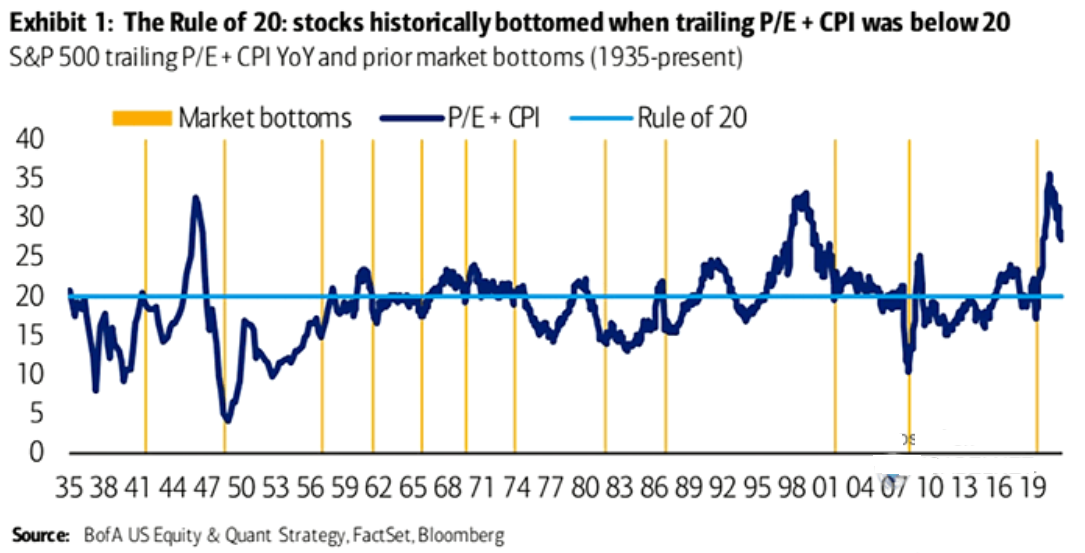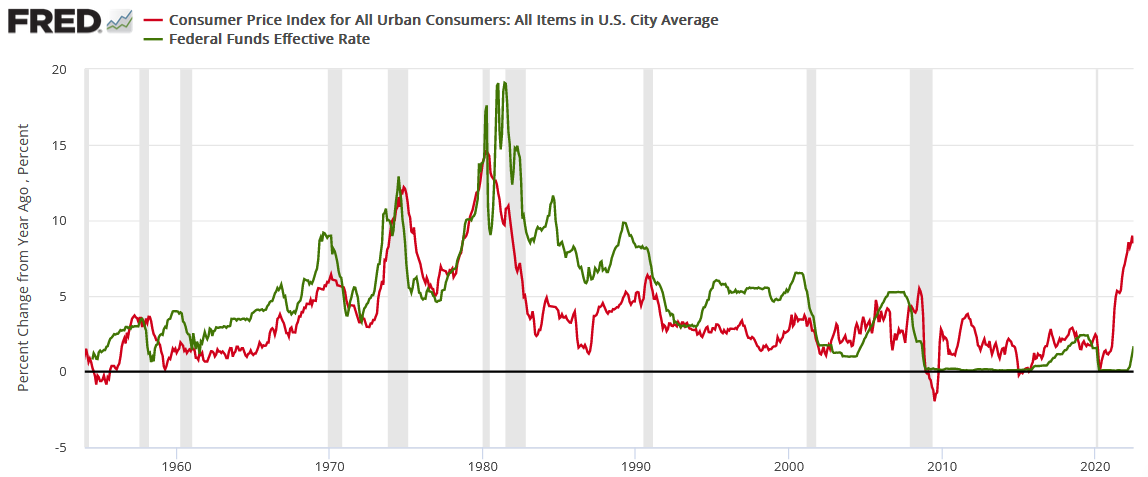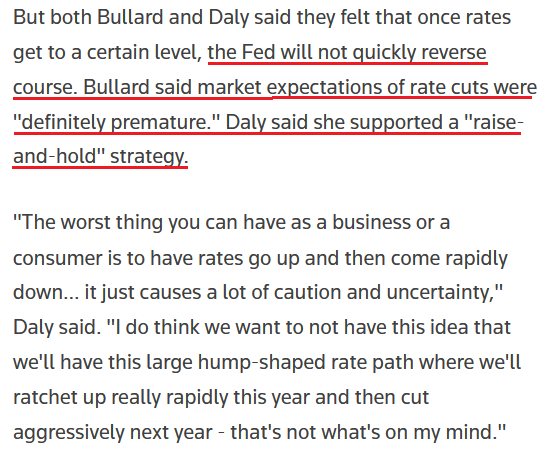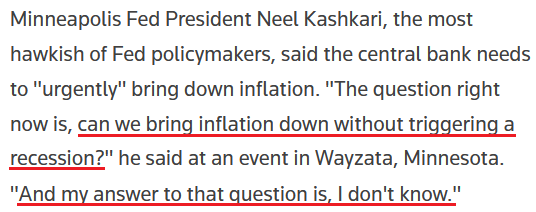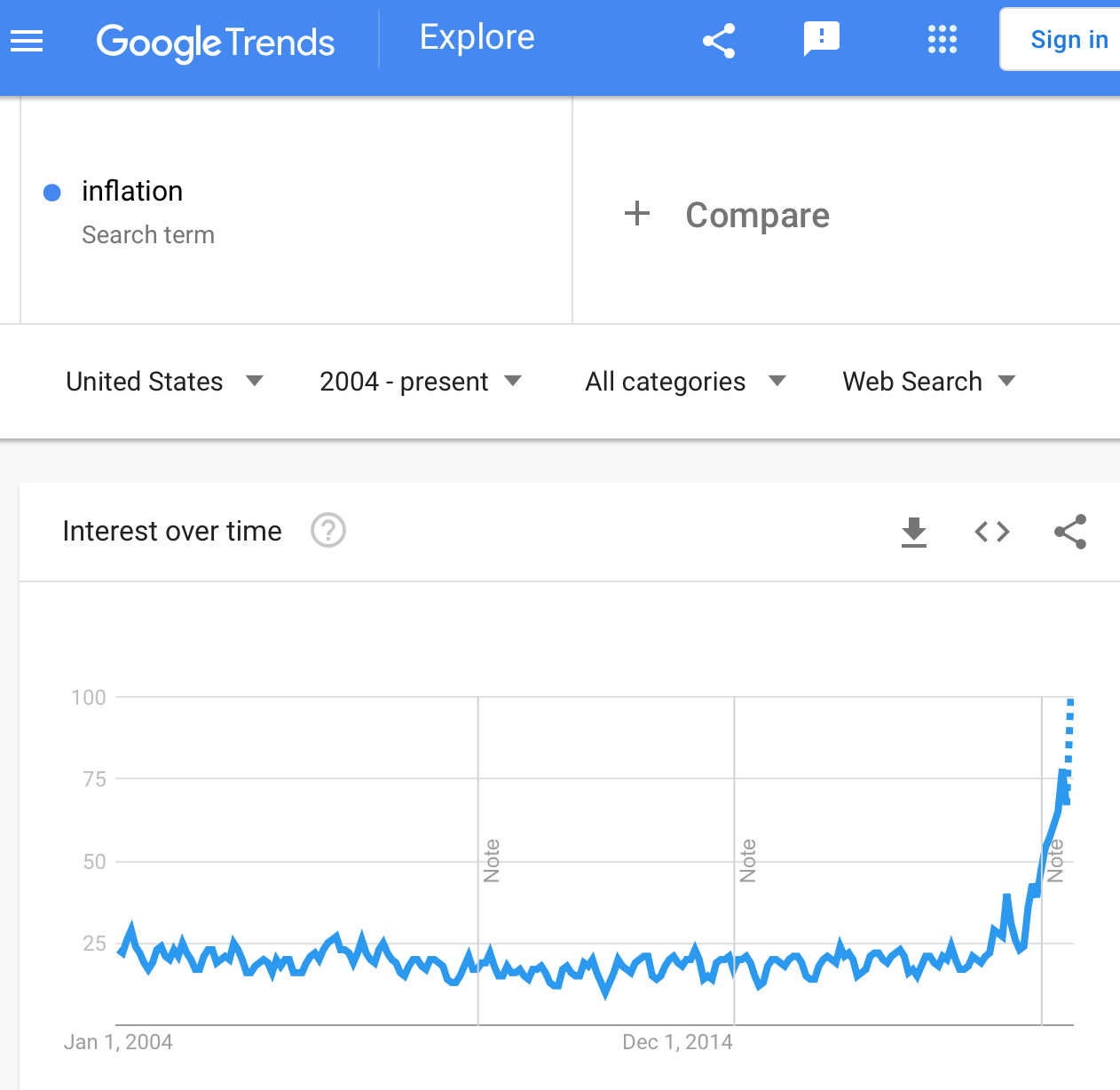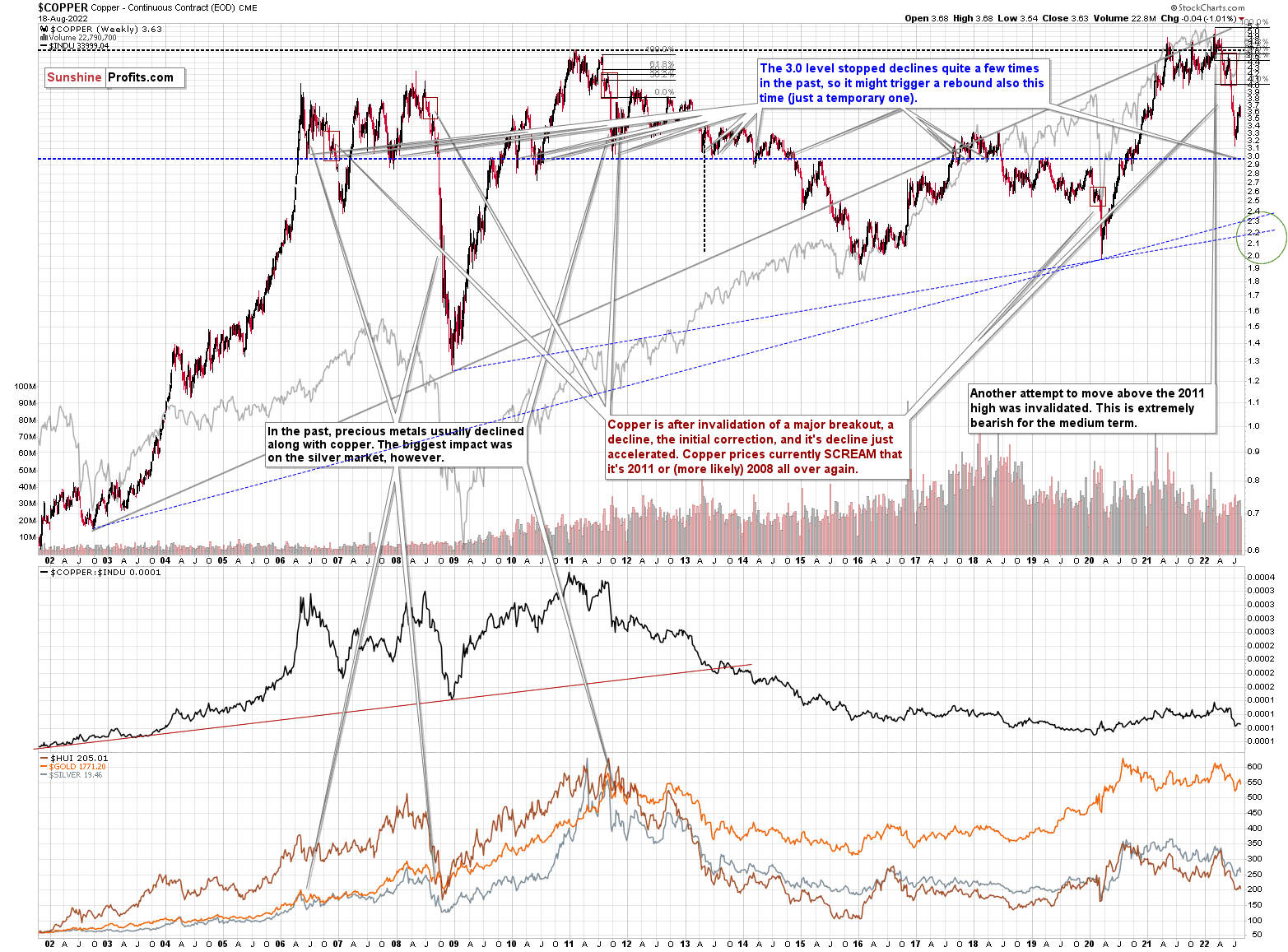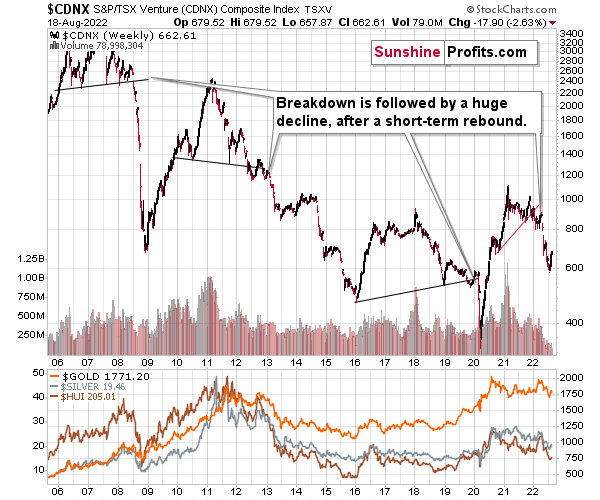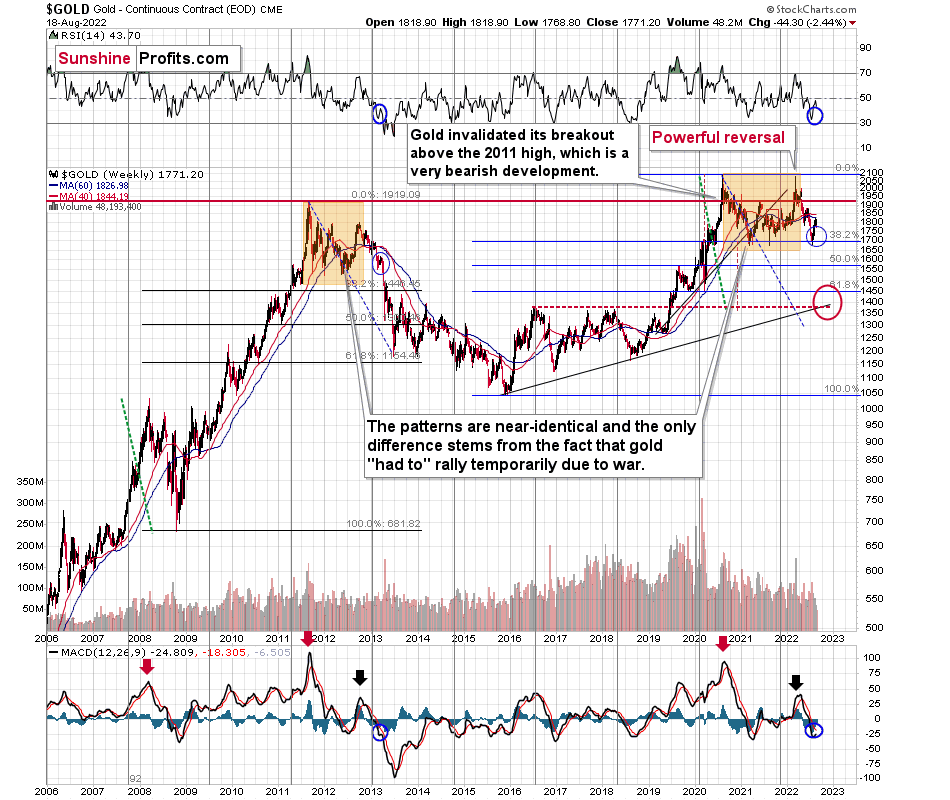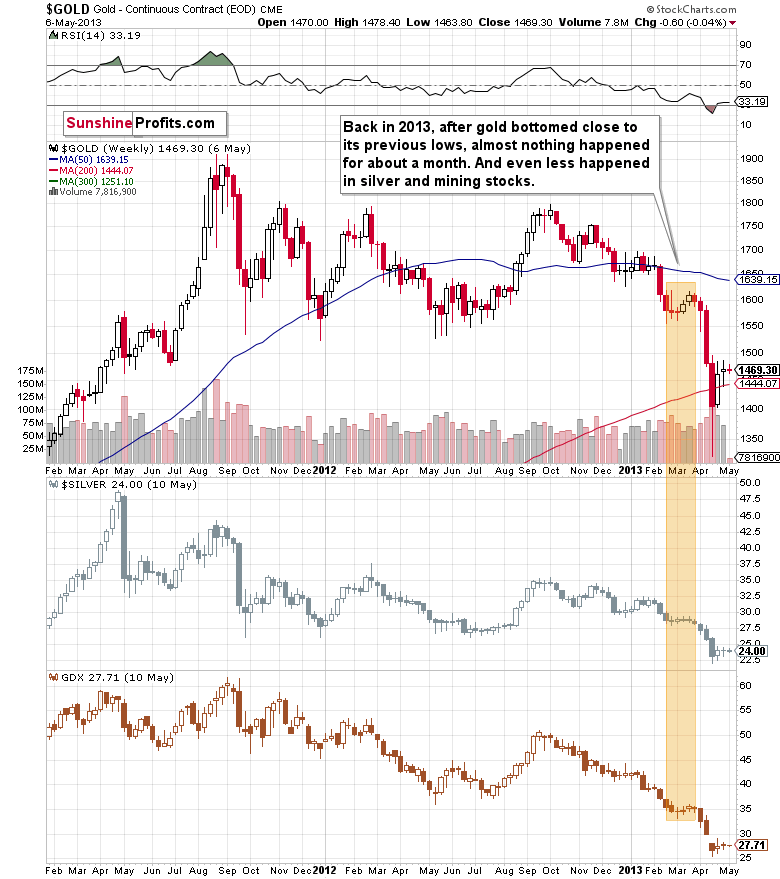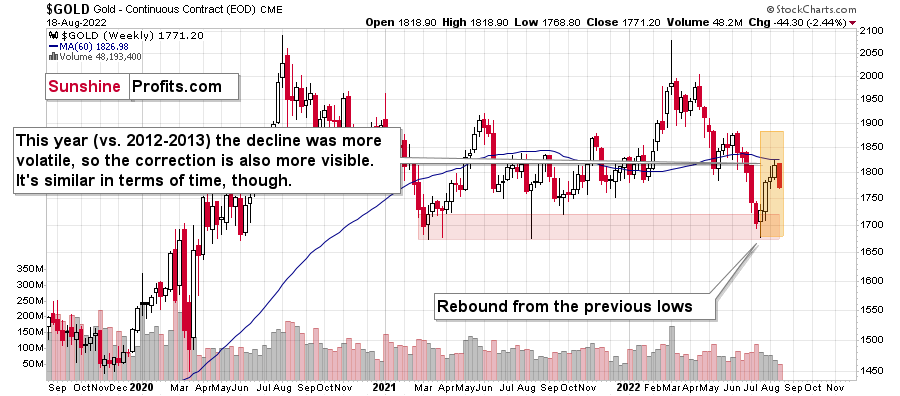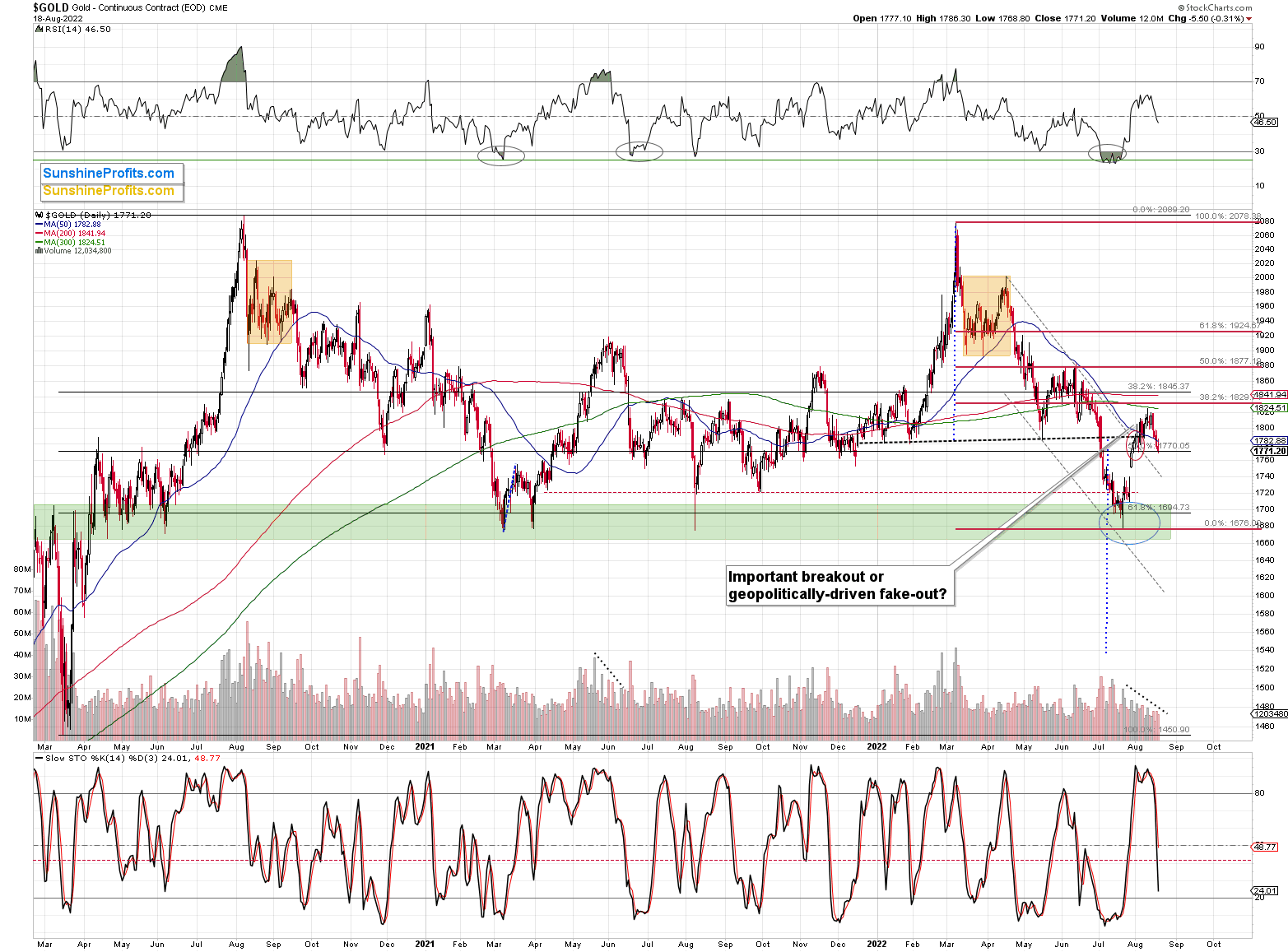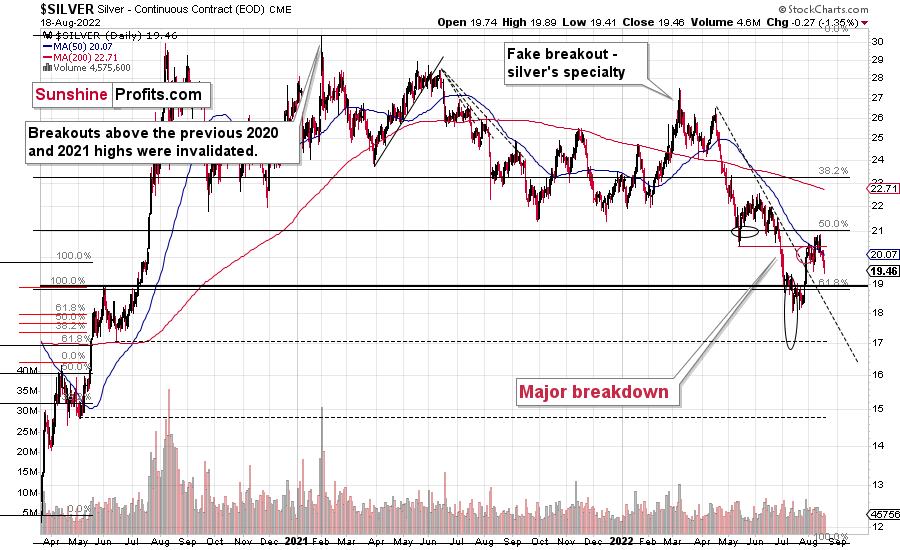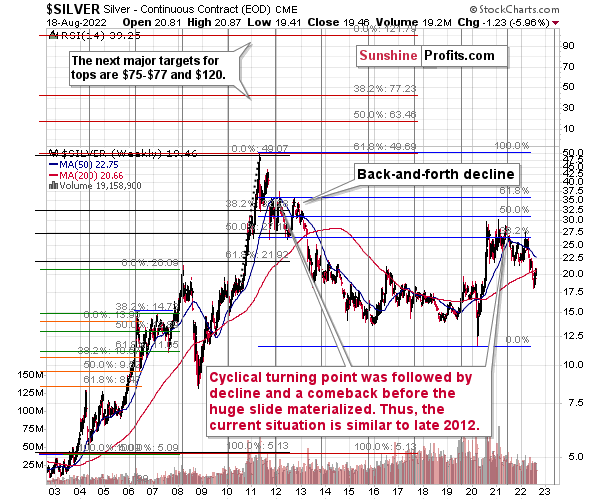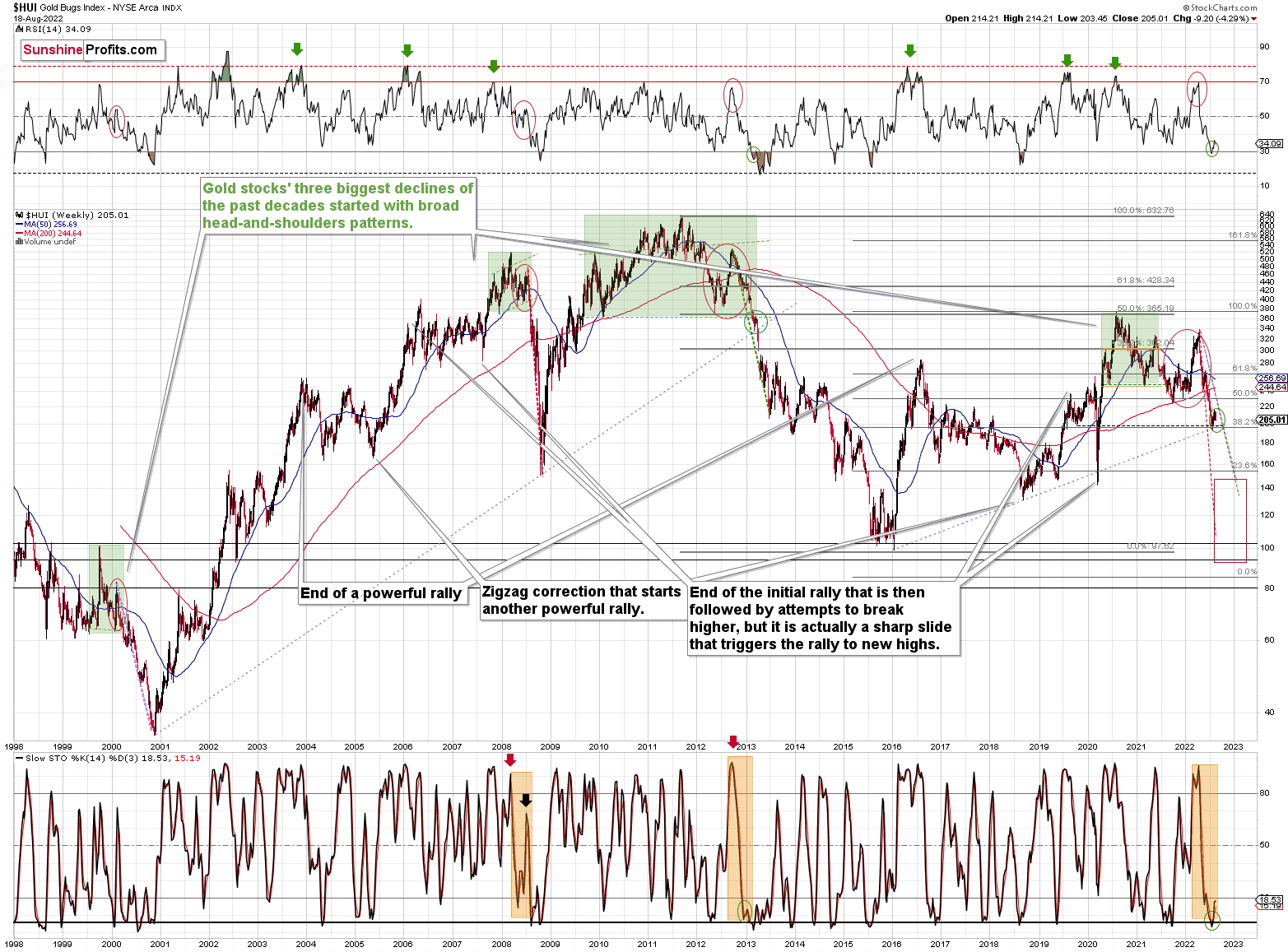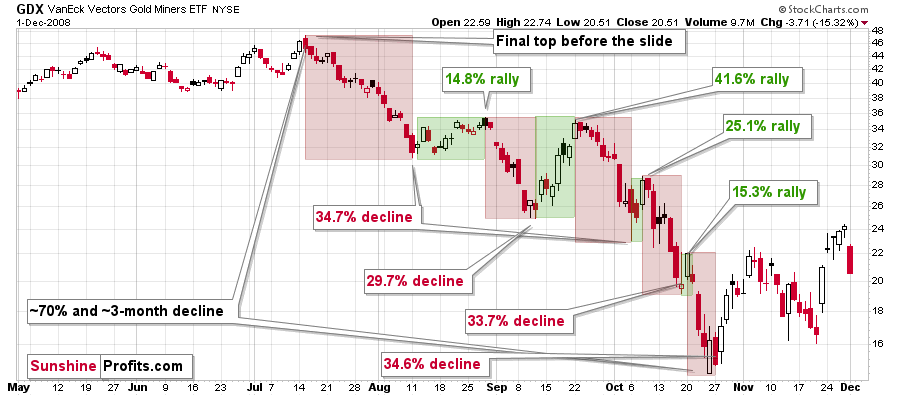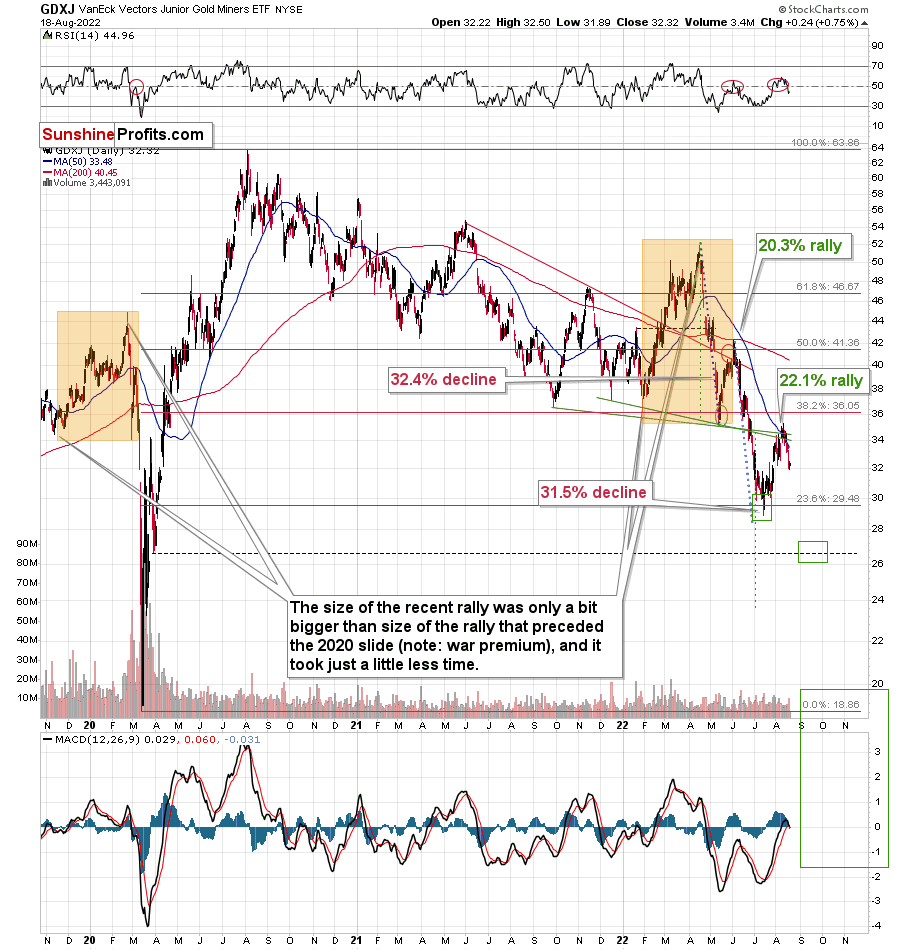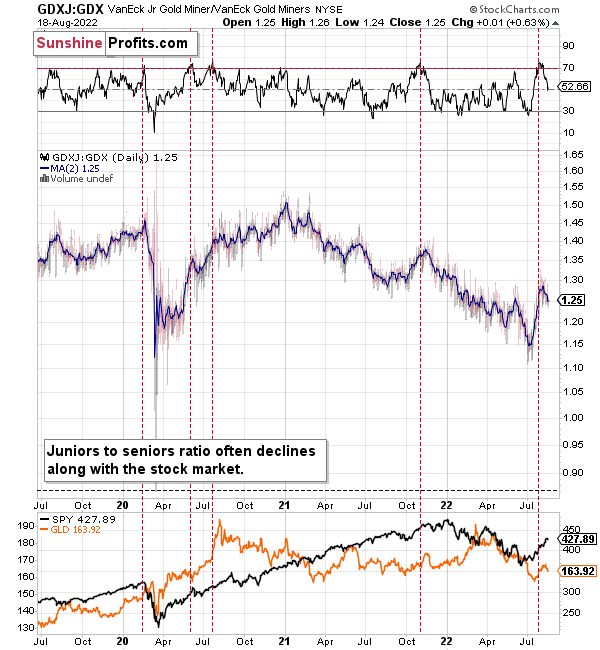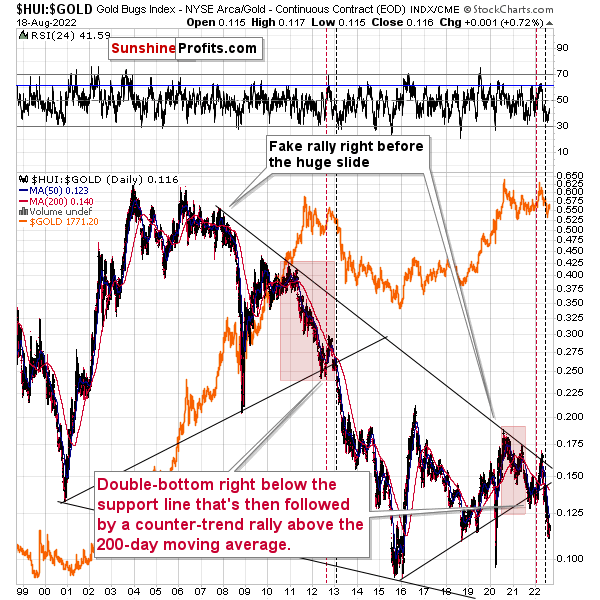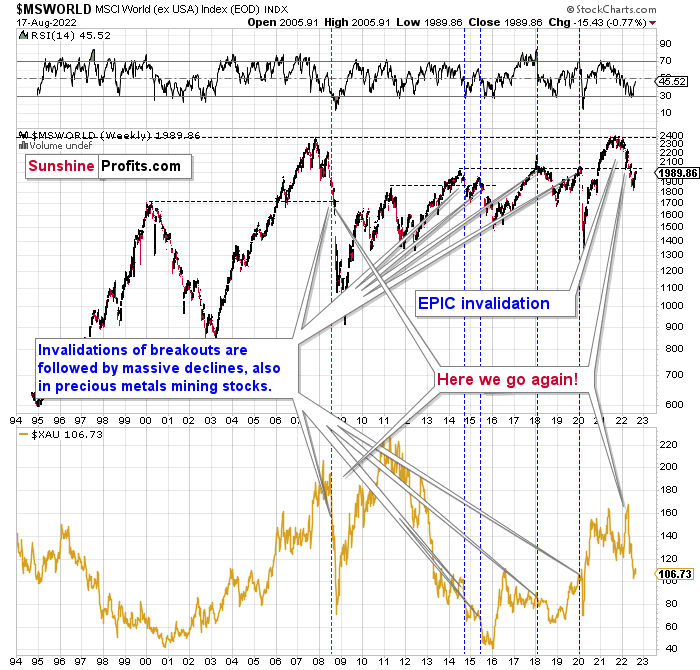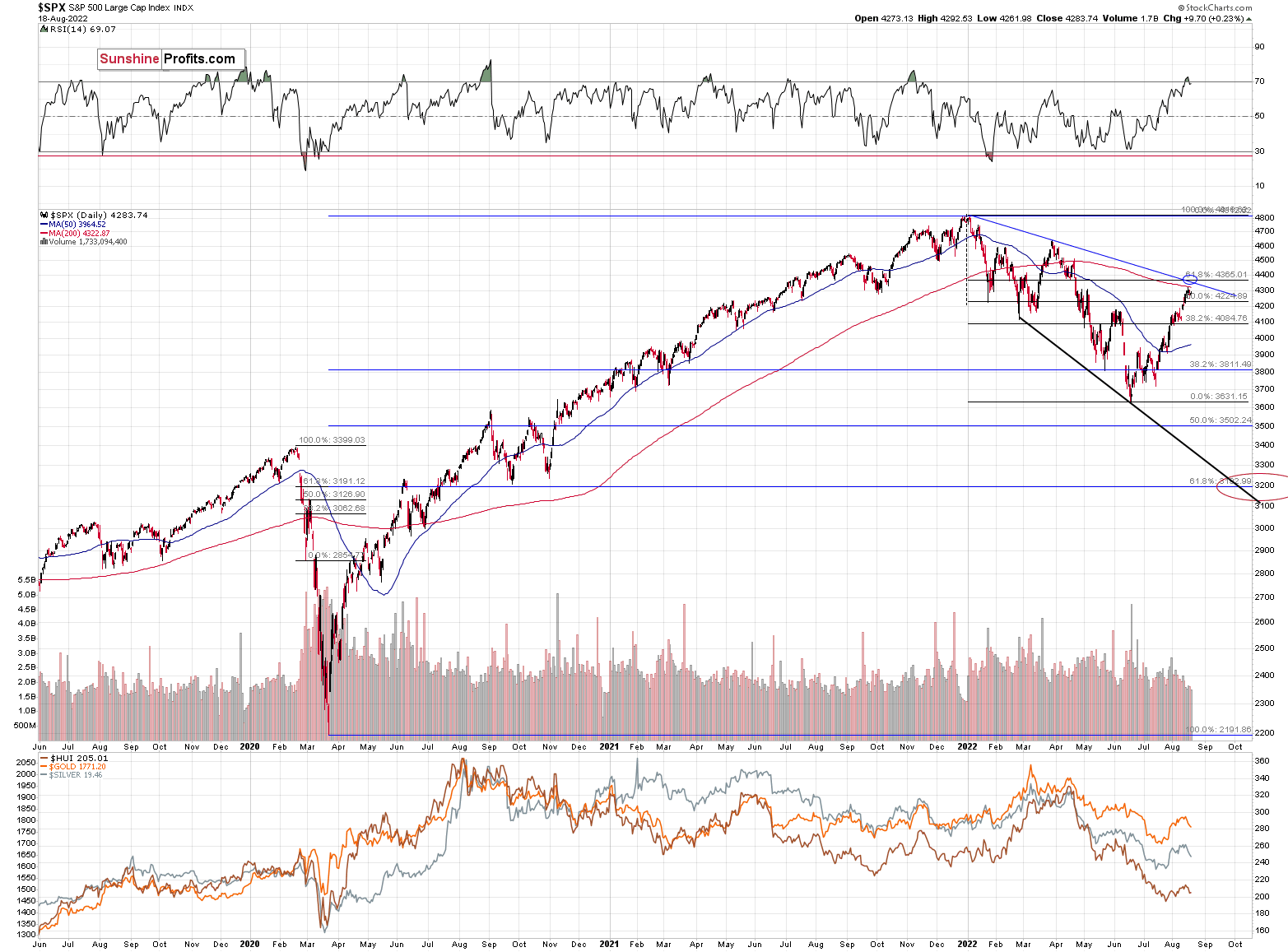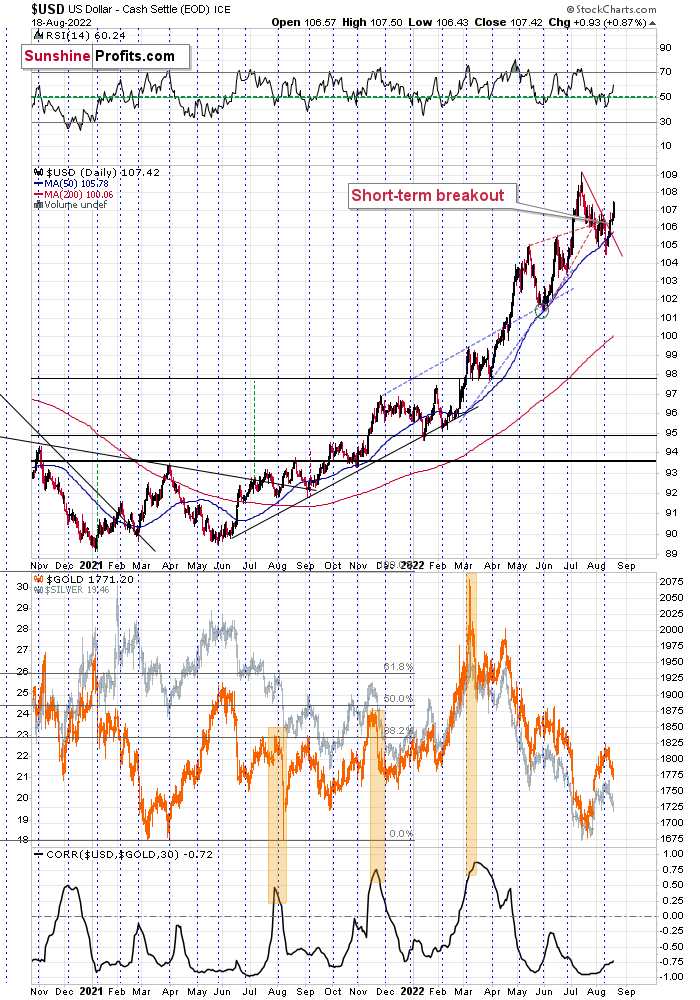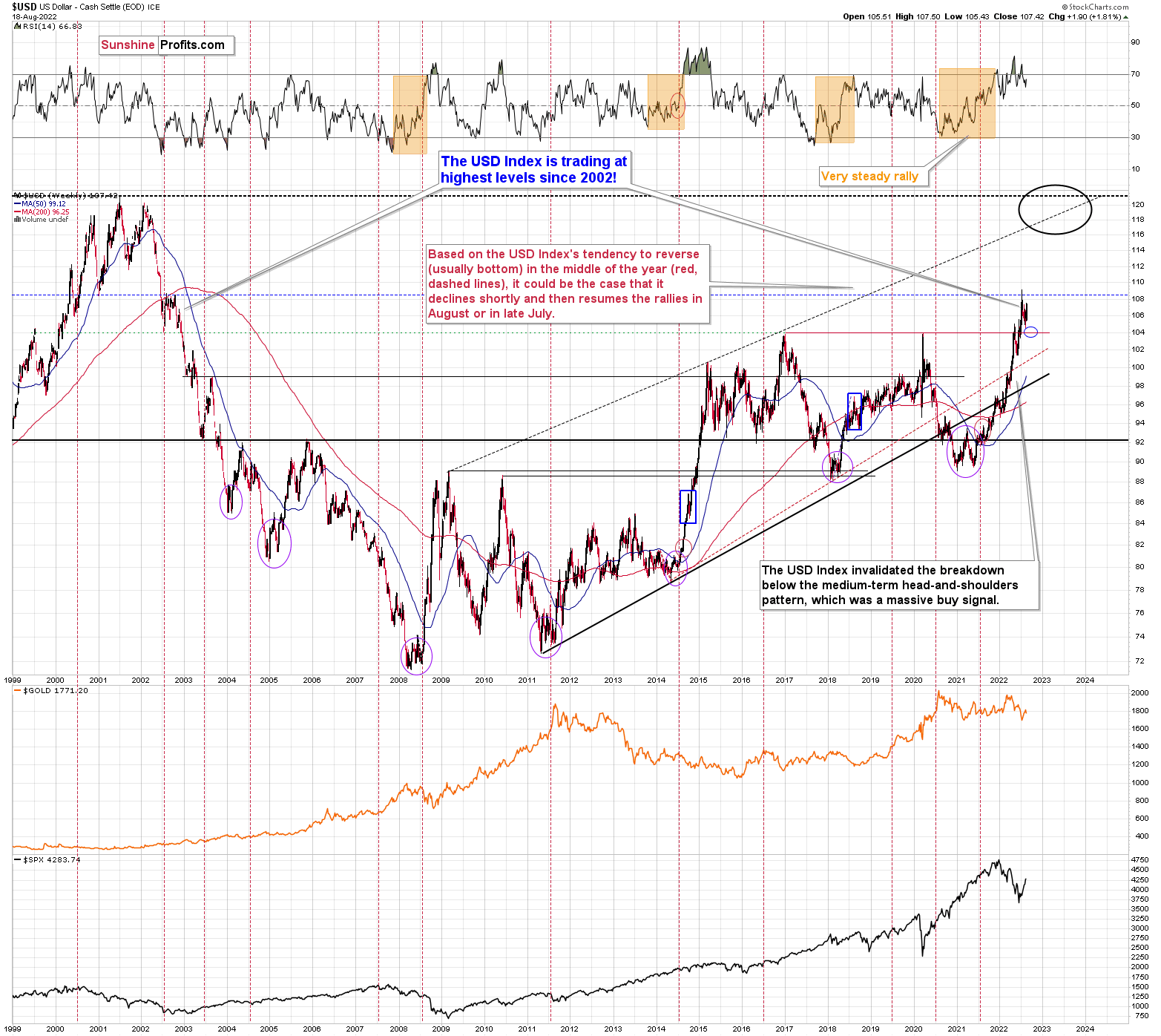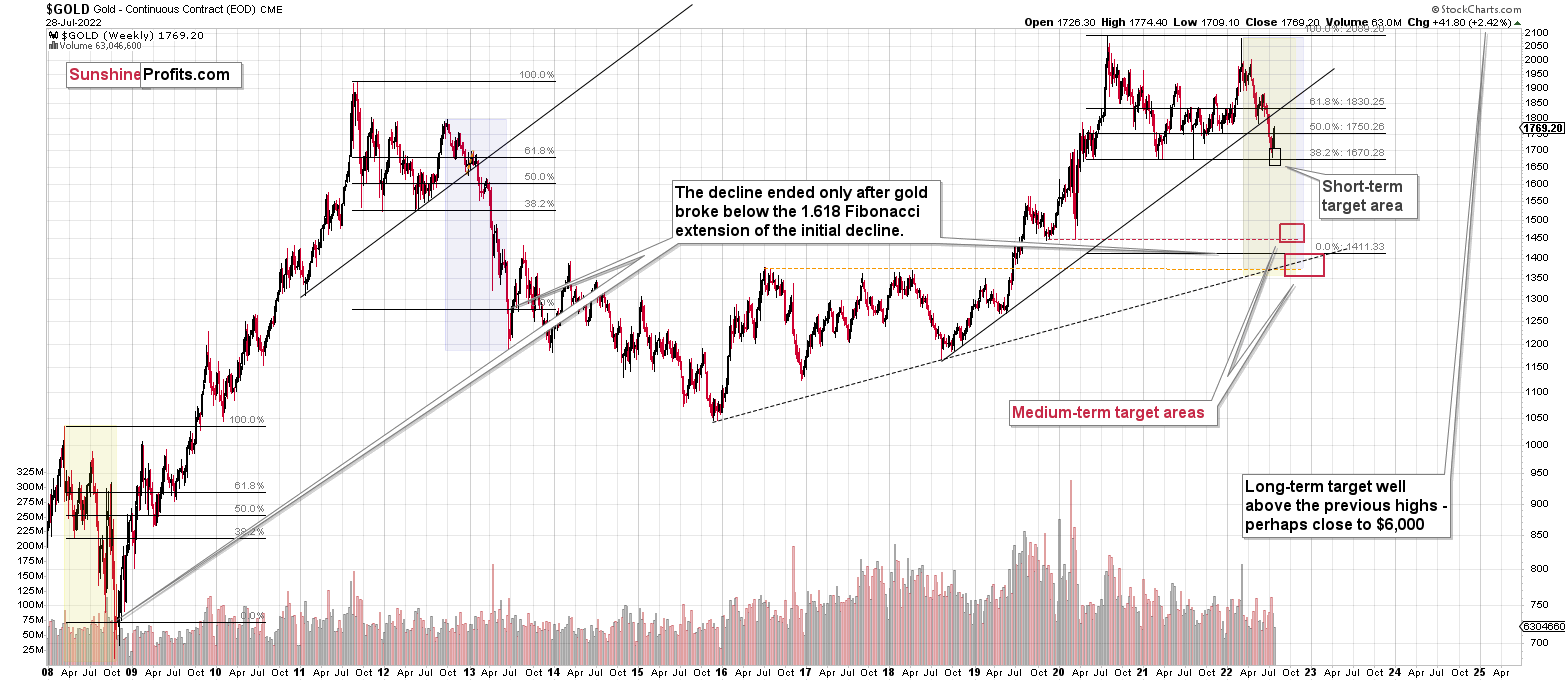Briefly: gold and the rest of the precious metals market are likely to decline in the next several weeks/months and then start another powerful rally. Gold’s strong bullish reversal/rally despite the USD Index’s continuous strength will likely be the signal confirming that the bottom is in.
PLEASE NOTE:
Dear Subscribers,
As the Author will be traveling this week, the Gold Investment Update will not be regular next Friday. Instead, it will focus on the recent fundamental aspects. PR will inform you about significant changes (which are unlikely). The next Gold Investent Update is scheduled fot Monday, August 29.
Stay tuned!
Welcome to this week's flagship Gold & Silver Trading Alert. Predicated on last week’s price moves, our most recently featured outlook remains the same as the price moves align with our expectations. On that account, there are parts of the previous analysis that didn’t change at all in the earlier days, which will be written in italics.
The key thing is that this week’s decline (not that huge, but profitable nonetheless) is in perfect tune with what happened in 2013, right before the biggest slide, so it can be viewed as the final part of the calm before the storm.
Let’s start today’s analysis with a recap of what recently happened on the fundamental front.
The Weekly Fundamental Roundup
This week was all about wishful thinking, as stock bulls continued to sound the all-clear amid “peak inflation.” However, while the U.S. equity market has levitated recently, gold, silver, and mining stocks have materially underperformed. Therefore, while risk-on sentiment should have lifted all boats, the PMs have essentially been left at the docks. As a result, their medium-term outlooks remain profoundly bearish.
Furthermore, with calls for a lasting bottom increasingly premature, valuation and the Consumer Price Index (CPI) highlight the challenges confronting the S&P 500 dip buyers.
Please see below:
To explain, the dark blue line above tracks the sum of the S&P 500’s trailing price-to-earnings (P/E) ratio and the year-over-year (YoY) percentage change in the headline CPI. In addition, the horizontal light blue represents the ‘Rule of 20’ – which opines that the S&P 500 is overvalued/undervalued when the sum of its trailing P/E and the YoY CPI is greater/less than 20.
Furthermore, the vertical orange bars represent historical market bottoms, or the end of cyclical bear markets. If you analyze their intersections with the dark blue line, you can see that the S&P 500 bottoms when the sum of its trailing P/E and the YoY CPI is less than 20. Likewise, some market bottoms occurred with the metric significantly below 20.
As such, the elevated reading on the right side of the chart shows that the current value is ~25. Thus, while I’ve presented several fundamental metrics with a ~70-year history of signaling why we’re likely far from a medium-term bottom, Bank of America’s findings stretch 85+ years.
To that point, Savita Subramanian, Bank of America’s Head of U.S. Equity and Quantitative Strategy, told clients on Aug. 17 that the Rule of 20 has a “perfect track record.”
“Our analysis of the [equity risk premium] ERP indicates a 20% likelihood of a recession is now priced in vs. 36% in June. In March, stocks priced in a 75% probability of recession.... Outside of inflation falling to 0%, or the S&P 500 falling to 2,500, an earnings surprise of 50% would be required to satisfy the Rule of 20, while consensus is forecasting an aggressive and we think unachievable 8% growth rate in 2023 already.”
Thus, while “inflation falling to 0%, or the S&P 500 falling to 2,500” is extremely unlikely in the short term, the canary in the coal mine is expected earnings growth. With Subramanian noting how 50% growth is needed to satisfy the Rule of 20, the 8% growth priced in for 2023 is already too high. Therefore, with earnings expectations overly optimistic and the Fed needing to reduce demand further to curb inflation, the data highlights why following the crowd is a dangerous game.
Decidedly Undecided
While Fed officials hope to curb unanchored inflation and engineer a soft landing, ~70 years of data show that a rate-hike-induced recession or a hyperinflationary collapse are the only cards left on the table. Furthermore, it’s likely only a matter of time before the consensus comes to the same conclusion. To explain, I wrote on Aug. 12:
The FFR has either eclipsed the YoY headline CPI or come within ~50 basis points of its peak in every inflation fight since 1954. Therefore, please see the unprecedented gap on the right side of the chart. With the YoY headline CPI peaking (for now) at 9.1% and the FFR at 2.5% (the high end of the Fed's 2.25% to 2.5% range), the difference is 6.6%.
As a result, history implies the FFR needs to hit at least 8.6% (which marks ~50 basis points below the current CPI peak). Moreover, while we don't expect the FFR to hit this level, the purpose is to show just how laughable a 3% FFR and 9%+ inflation is from a historical perspective. In reality, a 4.5%+ FFR is much more realistic, and the prospect is far from priced in.
In addition, notice how every inflation spike leads to a higher FFR and then a recession (the gray bars)? As such, do you really think this time is different?
Moreover, with Fed officials torn between a too hot or too cold approach, their lack of monetary policy conviction is extremely alarming. For example, St. Louis Fed President James Bullard said on Aug. 18 that "I don't really see why you want to drag out interest rate increases into next year." As a result, he reaffirmed his belief that the U.S. federal funds rate (FFR) should stand at a target range of 3.75% to 4% by the end of 2022 and that a 75-basis point increase is prudent in September.
However, San Francisco Fed President Mary Daly was indecisive about 50 or 75 basis points and noted that she expects the FFR to go "a little bit above" 3% by the end of 2022. Yet, she added, "we have to take [growth] into consideration as we ensure that we don't overdo policy."
Likewise, Kansas City Fed President Esther George said on Aug. 18 that "I think the case for continuing to raise rates remains strong. The question of how fast that has to happen is something my colleagues and I will continue to debate, but I think the direction is pretty clear. We have done a lot, and I think we have to be very mindful that our policy decisions often operate on a lag. We have to watch carefully how that's coming through."
Thus, while officials' forecasts were all over the place on Aug. 18, Bullard and Daly agreed that cutting interest rates is not on the table in 2023, despite investors’ pricing in the prospect.
Please see below:
In addition, Minneapolis Fed President Neel Kashkari – who went from the most dovish to the “most hawkish” – said on Aug. 18: "we need to get inflation down urgently" and: "we need to get demand down" by raising interest rates.
Therefore, while investors are completely loyal to the central bank (despite its long history of being wrong), market participants should learn the hard way that Fed officials' lack of conviction is an early warning sign of what's to come.
From Minutes to the Medium-Term
The Fed minutes were largely dovish, as officials advocated for a more data-dependent approach going forward. Moreover, their unwillingness to crack down on the pivot promoters has the futures market pricing in rate cuts in 2023. Thus, while officials have pushed back against the notion – like Bullard and Daly did on Aug. 18 – their rhetoric has yet to shake investors’ resolve.
However, Philip Marey, a Senior U.S. strategist at Rabobank, told clients on Aug. 17 that investors are confusing Fed officials’ poor communication skills with their medium-term intentions. He wrote:
“While the minutes are yet another piece of evidence that the Fed has prioritized price stability over full employment, markets are likely to remain deaf to the Fed’s repeated attempts to explain how they want to approach the current outbreak of inflation. If markets are going to be disappointed in their hopes for an early Fed pivot, it is not because the FOMC did not do enough to try to explain their plans. This one will be entirely attributable to the markets’ wishful thinking.”
Thus, while Rabobank expects the FFR to hit the 3.75% to 4% range by the end of 2022 (the Bullard forecast), Marey emphasized my warning that reducing inflation to 2% will be much more difficult than the consensus expects. As a result, the next shock to the financial markets should occur when investors lose faith in the Fed’s ability to orchestrate a soft landing.
The Bottom Line
While the PMs were largely left out in the cold during the recent risk rally, a sharp reversal from the S&P 500 could help ignite the next leg lower. Moreover, while many investors assume the bottom is in, reliable fundamental metrics signal the opposite. Therefore, while sentiment rules the day in the short term, gravity is undefeated, and overzealous bulls often learn this lesson the hard way.
In conclusion, the PMs were mixed on Aug. 18, as mining stocks rallied alongside the S&P 500 in the afternoon. However, with the USD Index recording another sharp daily rally, the latter should benefit from the continued liquidity drain, while the former should suffer. Moreover, with quantitative tightening (QT) set to double to $95 billion per month in September, the dry season should only intensify.
Are Voters Still Concerned with Inflation?
I wrote on many occasions that due to looming elections in the U.S., the priority will be where the voters’ attention and concerns are.
So, are people now less concerned with inflation than they were when Biden and Powell so openly spoke against it?
Here’s a chart from Google Trends showing the search frequency for “inflation”.
The answer is clear.
Absolutely not.
The voters are increasingly more concerned about the inflation. This means further rate hikes and overall monetary tightening are more likely, not less likely.
What to Watch for Next Week
With more U.S. economic data releases next week, the most important are as follows:
- Aug. 23: S&P Global U.S. Composite PMI, Richmond Fed manufacturing index
The data from S&P Global includes responses from nationwide manufacturers, so the growth, employment and inflation results are extremely important. Similarly, the Richmond Fed’s regional survey will provide insight into how these metrics are performing in Virginia.
- Aug. 25: KC Fed manufacturing index
Similar to the Richmond Fed’s regional survey, the KC Fed’s data will highlight the growth, employment, and inflation dynamics in Missouri.
All in all, economic data releases impact the PMs because they impact monetary policy. Moreover, if we continue to see higher employment, and inflation, the Fed should keep its foot on the hawkish accelerator. If that occurs, the outcome is profoundly bearish for the PMs.
Technically Speaking
Let’s start today’s technical discussion with a quick check on copper prices.
Practically, everything that I wrote about it last week (and in the previous weeks/months) remains up-to-date:
Copper recently CLEARLY invalidated another attempt to move above its 2011 high. This is a very strong technical sign that copper (one of the most popular commodities) is heading lower in the medium term.
It seems to me that there might be some kind of smaller corrective upswing or a pause when copper moves to about $3.0, but that it would then decline profoundly once again, only to bottom in the $2.0-2.4 area. That’s where we have rising, long-term support lines and also the previous – 2016 and 2020 – lows.
Interest rates are going up, just like they did before the 2008 slide. What did copper do before the 2008 slide? It failed to break above the previous (2006) high, and it was the failure of the second attempt to break higher that triggered the powerful decline. What happened then? Gold declined, but silver and mining stocks truly plunged.
Again, copper is after invalidation of a major breakout, a decline, the initial correction, and its decline just accelerated. Copper prices currently SCREAM that it’s 2011 or (more likely) 2008 all over again. This is extremely bearish for mining stocks (especially juniors) and silver.
No market moves in a straight line, up or down, but since we just saw a corrective upswing, the downtrend might now resume (or it might resume after an additional very short-term upswing).
Having said that, let’s check junior miners’ really big picture.
I previously commented on the above chart in the following way:
The Toronto Stock Exchange Venture Index includes multiple junior mining stocks. It also includes other companies, but juniors are a large part of it, and they truly plunged in 2008.
In fact, they plunged in a major way after breaking below their medium-term support lines and after an initial corrective upswing. Guess what – this index is after a major medium-term breakdown and a short-term corrective upswing. It’s likely ready to fall – and to fall hard.
So, what’s likely to happen? We’re about to see a huge slide, even if we don’t see it within the next few days.
Having said that, let’s turn to gold.
Let’s start with context:
Between 2020 and now, quite a lot happened, quite a lot of money was printed, and we saw a war breaking out in Europe. Yet, gold failed to rally to new highs.
In fact, it’s trading very close to its 2011 high, which tells you something about the strength of this market. It’s almost absent.
Truth be told, what we see in gold is quite in tune with what we saw after the 2011 top, and in particular, shortly after the 2012 top. The long-term gold price chart below provides details.
Please note that the 38.2% Fibonacci retracement based on the entire 2015-2020 rally is very close to $1,700, which makes the above-mentioned support area even stronger. Indeed, that’s when gold bottomed recently.
It seems that if it weren’t for the war in Europe, gold wouldn’t have been able to move above $2,000 and instead it would have topped close to its previous highs, which provided strong resistance.
The extraordinary thing about that is that that’s exactly what happened in 2012. Gold moved higher but only until it reached its previous highs, which happened in the second half of 2012.
This time the RSI was a bit higher, but it was close to 70, just like in 2012.
Yes, this time gold moved back to the previous high, but:
- This happened as a result of a geopolitical event (the war in Europe), and geopolitically-driven rallies are generally unsustainable;
- When gold reached its previous highs, it also formed a profound weekly reversal, which formed on huge volume, and that’s very bearish.
So, the current medium-term outlook for gold is very bearish.
There are also very interesting short-term takeaways from the above chart.
If the 2012-2013 is currently being replayed (at least to a significant extent), then let’s not forget that this decline initially took the shape of a back-and-forth decline with lower lows and lower highs (but there were notable short-term rallies within the decline).
The final of the corrections that still took place within the back-and-forth decline started in early 2013 - when gold moved close to its previous medium-term lows, when RSI was a bit above 30, and when the MACD was close to -20, which was also slightly below its previous medium-term low.
We can see all three above-mentioned similarities on the above chart. I marked them with blue ellipses. They are not “somewhat similar” – they are remarkably similar in both cases!
Indeed – gold rallied recently just like it had rallied in 2013, right before the most volatile part of the slide.
What does it imply going forward?
Please note that, based on the above-mentioned similarity, the corrective upswing in gold has probably already been completed or is about to be completed. Even at first sight, the rallies within blue ellipses appear practically identical. The RSI moved similarly higher as well.
The rally is bigger this time, but the geopolitical factors also contributed (China/Taiwan), but as we know, geopolitical factors tend to have only a temporary effect on prices.
Moreover, please note that this time, due to the Russian invasion on Ukraine, the price from which gold started its big decline was higher. As a result, gold declined in a more volatile manner, and thus it’s quite normal for it to correct in a more visible manner. Just like a ball that’s dropped from a higher altitude – it will bounce higher.
How low is gold likely to go during this upcoming decline? Perhaps as low as its 2020 low – to the $1,450-1,500 area.
I realize this is far from the current price, but nonetheless, this target area appears justified in my opinion. There are two important Fibonacci retracements based on the 2015-2020 rally that gold can bounce from (it recently bounced from the 38.2% retracement). These are 50% and 61.8% retracements.
The support provided by the 61.8% retracement is strengthened by the 2020 low and the support provided by the 50% retracement is strengthened by the 2019 high.
However, based on gold’s self-similarity to 2013, it seems that we’re about to see a slide that’s bigger than what we’ve been seeing so far this year. This time – based on the similarity – gold is likely to decline profoundly, but no longer in the back-and-forth mode. If gold formed its next local low at the 50% retracement (so at about $1,560), then it might do so still within the declining, short-term trend channel (sometime in September).
However, if gold is to stick to the link to 2013, then it should decline more rapidly. In this case, the technique that can help us estimate the short-term target is the one that says that after a breakdown from a trend channel, price is likely to move approximately by as much as the height of the previous trend channel. In this case, gold could break below the trend channel soon and then decline even more. Based on the height of the trend channel, the above means that a move to the 61.8% retracement as the next downside target is more likely than a move to the 50% retracement.
Besides, the decline in gold would likely be linked to a breakdown in the EUR/USD below 1, which – if confirmed – would likely trigger significant selling.
On the fundamental news front, this fits the current situation as well. The likelihood of real interest rates moving higher in the future didn’t decrease at all, but at the same time, the market focused on something insignificant – Powell’s speech. Yes, it was insignificant because of all the times Powell’s suggestions didn’t result in actual action. Also, wasn’t it Powell who spoke many times about the benefits of higher interest rates, but then cut them (probably as he was pressured to do so by Trump)?
This time, the pressure is different – people are most concerned with inflation, and the latter has become political. So, while it remains clear that real interest rates are going up, the market’s perception triggered this artificial short-term rally, which means that now the gold price has more room to fall.
However – just because something is likely to happen, doesn’t mean that it’s likely to happen right away. So, let’s zoom in on what happened in 2013 after the analogous rebound.
Well, gold consolidated for a few weeks and plunged only after that consolidation.
That’s what we saw recently as well. Of course, we haven’t seen the big plunge yet, but the other parts of the recent price patterns are very, very similar to what we saw in 2013.
While it doesn’t guarantee that we’ll see a pause that’s as long as the one that we saw before the April 2013 slide, it’s a good indication that the huge decline is likely just around the corner, as the corrections in both cases are very similar in terms of time. The fact that the current one is bigger is perfectly understandable given the current geopolitical turmoil.
For now, investors and traders might view the current prices as temporary, and they might expect gold to soar back up. In fact, I saw multiple analyses indicating exactly that. This means that a week or a few weeks of back and forth trading close to the current price levels or between the current price levels and the recent lows would help to convince them that this move lower was not accidental.
This would make them much more likely to sell (and panic) once gold breaks below its recent lows.
Gold moved a bit higher recently, and it almost touched its 38.2% Fibonacci retracement level. Even if it does touch it, it will still remain in the “corrective mode” in Fibonacci terms. However, since gold declined by over $40 this week, it seems quite likely that the short-term top is already in, and thus that this level won’t be reached in the near future.
As I wrote earlier today, the recent correction and then the back-and-forth movement are perfectly normal given the analogy to 2013. It’s most likely not the start of another powerful rally, but rather something in tune with what happened during the previous huge, medium-term decline.
Is the rally already over? This could be the case. The yellow metal practically touched its 300-day moving average (green line) and then moved back down. Gold is moving lower in today’s pre-market trading as well.
At the moment of writing these words, gold futures are trading at about $1,767, which means that it’s already trading at fresh August 2022 lows. In today’s London trading, the GDXJ is also trading at fresh August 2022 lows.
Consequently, what I wrote previously remains perfectly up-to-date – the precious metals sector is currently likely to do pretty much nothing, and then it’s likely to slide in an epic manner. So far, we’re still in the calm-before-the-storm mode.
Silver and mining stocks are likely to be affected even more than gold, though.
Let’s take a look at the silver market.
Like gold, silver just hit my previous target area. It touched its 50-day moving average and its May bottom. Since that time, silver tried to move higher, but it wasn’t able to do so. At the moment of writing these words, silver futures are trading at 19.13, which means that they, too (like gold and GDXJ), moved to fresh August 2022 lows.
Silver is moving back and forth just like gold is, and it’s perfectly normal given the analogy to 2013. The outlook for the following weeks and months remains very bearish.
Furthermore, during its recent upswing, silver outperformed gold on high volume, which we frequently see as confirmation of a short-term top being in or near. How low will silver now move? This is rather unclear, because things can now get very volatile (like in 2008, 2013 or 2020), and it seems to be a better idea to be looking at gold than at silver when determining the exit moment for the white metal.
However, to provide you with some numbers, I’d say that silver is likely to decline at least to $15 before the next important correction. I wouldn’t be surprised to see it fall all the way down to its 2020 low of $12 before moving up in a more visible way.
As you see, the silver outlook is not as precise as it is for gold, as the support levels and targets based on multiple techniques don’t necessarily align. In the case of gold, they do.
Let’s not forget that gold is not the only precious metal that is repeating its 2012 performance right now, and you can see more details on silver’s long-term chart.
As you can see on the above chart, silver corrected about 50% of the previous downswing, and this correction ended at about $30, a long time ago. Ever since, silver has been declining, and even the outbreak of war in Europe didn’t make silver rally above that level.
On the above chart, you can see how silver first topped in 2011, then declined and formed another top at the cyclical turning point. Next, it declined once again – to the previous lows. After that, silver rallied (in 2012 and 2022), and it topped between its 50-week moving average (marked in blue) and the previous top. Now silver is declining in a back-and-forth manner (you can see it more clearly on the previous short-term silver chart).
Back in 2012, these were just the early days of a gargantuan decline, and the same appears likely to be the case this time. Interest rates are going up after all, and the Fed is determined to quench inflation.
Let’s not forget that rising interest rates are likely to negatively impact not just commodities, but practically all industries. This will likely cause silver’s price to decline profoundly, as silver’s industrial demand could be negatively impacted by lower economic growth (or a decline in economic activity).
Besides, please note that silver didn’t even manage to rally as much as copper (which tried to move to new highs recently) or most other commodities, thus being rather weak.
Consequently, it seems that silver will need to decline profoundly before it rallies (to new all-time highs) once again.
Having said that, let’s take a look at what happened in mining stocks.
History tends to repeat itself. Not to the letter, but in general. The reason is that while economic circumstances change and technology advances, the decisions to buy and sell are still mostly based on two key emotions: fear and greed. They don’t change, and once similar things happen, people’s emotions emerge in similar ways, thus making specific historical events repeat themselves to a certain extent.
For example, right now, gold stocks are declining similarly to how they did in 2008 and in 2012-2013.
The Russian invasion triggered a rally, which was already more than erased, and if it wasn’t for it, the self-similarity would be very clear (note the head-and-shoulders patterns marked with green). Since the latter happened, it’s not as clear, but it seems that it’s still present. At least that’s what the pace of the current decline suggests.
I used a red dashed line to represent the 2008 decline, and I copied it to the current situation. They are very similar. We even saw a corrective upswing from more or less the 200-week moving average (red line), just like what happened in 2008.
We saw a breakdown to new short-term lows, which means that the volatile part of the slide is likely already underway.
Moreover, four weeks ago, I commented on the above chart in the following way:
On a short-term basis, we see a short-term (only) downside target of around 200. That’s about 10% below yesterday’s (Thursday’s) closing price. There are several reasons for it:
- It’s a round number, and those tend to be more important psychologically than other numbers.
- That’s where we have the rising medium-term support line based on the 2016 and 2018 lows. The temporary move below this line triggered a massive rally in 2020.
- That’s where we have the 61.8% Fibonacci retracement level based on the entire 2016-2020 rally.
The 200 target was then reached and briefly breached, and it was followed by a rally.
Analogy-wise, it’s what we previously saw in 2013. It might not be obvious which part of the chart to look at, as the upswings are not that visible from the long-term point of view, so I marked them with green ellipses (also in RSI and Stochastic).
How low can the HUI Index fall during the next big downswing?
As it’s the case with gold and silver, a move back to the 2020 lows is definitely in the cards. Please note that this level is also strengthened (as support) by other major lows: the 2019, 2014, and 2008 ones.
However, I wouldn’t rule out a move even lower on a temporary basis. If gold were to decline to about $1,450-1,500, it would mean that it would double its current 2022 decline. If the HUI Index does that, it will move below 150.
So, all in all, 120-150 is my current target area for the upcoming slide in the HUI Index.
All right, let’s zoom in and see how mining stocks declined in 2008.
Back then, the GDXJ ETF was not yet trading, so I’m using the GDX ETF as a short-term proxy here.
The decline took about 3 months, and it erased about 70% of the miners’ value. The biggest part of the decline happened in the final month, though.
However, the really interesting thing about that decline – that might also be very useful this time – is that there were five very short-term declines that took the GDX about 30% lower.
I marked those declines with red rectangles. After that, a corrective upswing started. During those corrective upswings, the GDX rallied by 14.8-41.6%. The biggest corrective upswing (where GDX rallied by 41.6%) was triggered by a huge rally in gold, and since I don’t expect to see anything similar this year, it could be the case that this correction size is an outlier. Not paying attention to the outlier, we get corrections of between 14.8% and 25.1%.
The interesting thing was that each corrective upswing was shorter (faster) than the preceding one.
The first one took 12 trading days. The second one took seven trading days. The third one took 2 trading days, and the fourth and final one took just 1 trading day.
Fast forward to the current situation. Let’s take a look at the GDXJ ETF.
The GDXJ ETF had declined by 32.4% and then it corrected – it rallied by about 20.3%.
Later, it had declined by about 31.5% and then rallied by about 22.1%.
The second decline and the second corrective upswing are bigger, just like it was the case in 2008.
Back then, gold rallied profoundly, which triggered a bigger corrective rally than the one that we just saw, but other than that, the situations seem similar.
Technically, junior miners moved to their May lows, and they verified them as resistance. The next wave lower can - and is likely to - now begin.
I previously wrote the following:
What does it tell us? It indicates that history can be rhymed, and while it will not be identical, we should pay attention to the indicators that worked in 2008. The next corrective upswing (a notable one, that is) might start when the GDXJ ETF declines by about 29%-35% from its recent top. To clarify, I don’t claim that the above technique would be able to detect all corrective upswings, or that I aim to trade all of them. For instance, in my view, it was a good idea to enter a long position on May 12 and switch to a short position on May 26, but I wasn’t aiming to catch the intraday moves.
Based on how long the corrective upswings took in 2008 and how long the recent one took, the upcoming corrective upswing is likely to take between 5 and 10 trading days. If the bottom formed yesterday, which seems likely as the GDXJ ETF is already up by over 1% in today’s London trading, then we can expect the next local top to form within 1-2 weeks. In other words, it seems that the corrective upswing is likely to end in the next part of July – probably in its final week.
Back in 2008, the counter-trend rallies varied greatly in their magnitude, but please keep in mind that back then, the decline was very much news-based – Lehman Brothers’ collapse, etc. This time, the decline is more measured, so declines and corrections are more measured as well.
While back in 2008, during the first correction, the GDX gained only 14.8% and during the second one it gained a sizable 41.6%, this time the first rally provided a measured 20.3% increase. If the upcoming correction is also measured, then the GDXJ might also rally by about 20%.
It appears that it’s exactly what we saw. The medium-term downtrend can now continue (or if it hasn’t started yet, it might start soon).
How low can the GDXJ ETF move during the (this?) next big move lower? A move to its 2020 lows (~$20) seems quite likely.
Yes, it is possible that the GDXJ ETF will fall below its 2020 lows, but it might need to correct first.
Please note that a move to the 2020 lows (~$20) is something that fits what I wrote about gold and the HUI Index - that they could repeat their so-far 2022 decline (approximately).
I previously added an extra short-term downside target of about $26.5. If GDXJ gets there while gold re-tests its previous lows once again, then we might get one tiny rebound just before the slide. But it seems too small to be worth trading, as the risk associated with missing the much bigger move lower might not justify the potential quick gain.
Moreover, please note that due to their recent outperformance, juniors can now reverse their trend and decline more than senior miners – this would fit a situation in which the general stock market declines.
During their previous upswing, juniors rallied relative to seniors, and the situation was recently excessive from the short-term point of view. At least the RSI indicator suggested that juniors were now likely to decline relative to seniors.
It seems that this next move lower in juniors to seniors is already underway. The RSI seems to have topped above 70, and the ratio itself seems to have formed a top too.
This implies bigger declines in the GDXJ in the future.
Also, let’s not forget about the forest while looking at individual trees. By that, I mean looking at how gold stocks perform relative to gold. That’s one of the major indications that the current situation is just like what we saw at the 2012 top.
The situation in the gold stock to gold ratio is similar to what we saw in late 2012 and early 2013. The HUI to gold ratio invalidated its first attempt to break lower (marked with red, dashed lines), but after a corrective upswing, it then broke lower more decisively. That’s what I marked using black, dashed lines.
If history is to rhyme, we’re about to see a profound decline. In fact, we’re likely already past its beginning.
Also, please note that the pattern that we currently see, which started in early 2016, is somewhat similar to what happened between 2003 and 2008.
Back in 2008, the breakdown from the consolidation resulted in sharply lower ratio values and much lower prices of gold stocks.
So, if the situation is analogous to 2012-2013, we’re likely to see a big decline in the following weeks/months, and if it’s analogous to 2008, we’re likely to see an enormous decline in the following weeks/months.
Declining stock prices would only add fuel to the bearish fire (after all, gold stocks are… just stocks) and that’s exactly what’s likely to happen.
The technical picture in the case of world stocks remains extremely bearish, and my previous comments on it were just confirmed. Here’s what I’ve been writing about the above chart for quite a few weeks now:
World stocks have already begun their decline, and based on the analogy to the previous invalidations, the decline is not likely to be small. In fact, it’s likely to be huge.
For context, I explained the ominous implications on Nov. 30. I wrote:
Something truly epic is happening in this chart. Namely, world stocks tried to soar above their 2007 high, they managed to do so, and… failed to hold the ground. Despite a few attempts, the breakout was invalidated. Given that there were a few attempts and that the previous high was the all-time high (so it doesn’t get more important than that), the invalidation is a truly critical development.
It's a strong sell signal for the medium - and quite possibly for the long term.
From our – precious metals investors’ and traders’ – point of view, this is also of critical importance. All previous important invalidations of breakouts in world stocks were followed by massive declines in mining stocks (represented by the XAU Index).
Two of the four similar cases are the 2008 and 2020 declines. In all cases, the declines were huge, and the only reason why they appear “moderate” in the lower part of the above chart is that it has a “linear” and not a “logarithmic” scale. You probably still remember how significant and painful (if you were long, that is) the decline at the beginning of 2020 was.
All those invalidations triggered big declines in the mining stocks, and we have “the mother of all stock market invalidations” at the moment, so the implications are not only bearish, but extremely bearish.
World stocks have declined below their recent highs, and when something similar happened in 2008, it meant that both stocks and gold and silver mining stocks (lower part of the chart) were about to slide much further.
The medium-term implications for mining stocks are extremely bearish.
However, let’s get back to the short- and medium-term points of view.
Stocks rallied recently, but since they corrected approximately to their previous June highs and March lows, the rally might be over, or very close to being over.
Especially since the RSI had just moved above 70, and then it declined back below this level. This indicated local tops many times in the past.
As I had indicated previously, interest rates are likely going up, which is a bearish factor for the stock market, and the recent rally was likely due to the market’s misinterpretation of the importance of Powell’s speech. The S&P 500 wanted to correct (based on emotional = technical reasons) and it used Powell’s seemingly dovish comments as an excuse to do so. However, what materially changed? Nothing. Interest rates are likely to be raised, as inflation remains the key political issue right now, and the markets are likely to respond by declining.
Most interestingly, though, such a decline would likely have a devastating effect on the prices of mining stocks (especially junior mining stocks) and silver. There might be some impact on gold, too.
The above would also be in tune with an extra rally in the USD Index. After all, less competitive exports are not that favorable for the U.S. economy.
The USD Index had recently moved slightly below its 50-day moving average, and then it moved back above it.
After that, it started to rally, and it has continued to rally until this moment.
This move is in tune with what we saw at previous local bottoms. The RSI moved slightly below 50, which used to accompany bottoms in the previous months.
So, the scenario in which the USD Index has already bottomed seems quite likely.
I previously wrote the following about the USD Index’s long-term chart:
There’s also the possibility that the USD Index keeps declining until it reaches the very strong support at about the 104 level – the previous long-term highs (…).
Last week, the USD Index bottomed at about 104.5, which was very close to the above-mentioned 104 level. If traders had expected the USD Index to bottom at this level, then some of them might have bought at higher levels in order to maximize their odds of catching the bottom, thus actually creating the bottom at higher levels.
Since the USD Index is already (at the moment of writing these words) back above the 107.5 level, it could be the case that the short-term bottom is already in. Actually, there were only five sessions this year when the USD Index closed at levels that were higher than the current USDX value.
This, in turn, likely means that the peak for precious metals is already in.
Overview of the Upcoming Part of the Decline
- It seems to me that the corrective upswing is either over or about to be over, and that the next big move lower is about to start.
- If we see a situation where miners slide in a meaningful and volatile way while silver doesn’t (it just declines moderately), I plan to – once again – switch from short positions in miners to short positions in silver. At this time, it’s too early to say at what price levels this could take place and if we get this kind of opportunity at all – perhaps with gold prices close to $1,600.
- I plan to exit all remaining short positions once gold shows substantial strength relative to the USD Index while the latter is still rallying. This may be the case with gold close to $1,400. I expect silver to fall the hardest in the final part of the move. This moment (when gold performs very strongly against the rallying USD and miners are strong relative to gold after its substantial decline) is likely to be the best entry point for long-term investments, in my view. This can also happen with gold close to $1,400, but at the moment it’s too early to say with certainty.
- The above is based on the information available today, and it might change in the following days/weeks.
You will find my general overview of the outlook for gold on the chart below:
Please note that the above timing details are relatively broad and “for general overview only” – so that you know more or less what I think and how volatile I think the moves are likely to be – on an approximate basis. These time targets are not binding nor clear enough for me to think that they should be used for purchasing options, warrants, or similar instruments.
Summary
Summing up, it seems that the corrective upswing is over (or close to being over), which means that the powerful medium-term downtrend can now resume.
Two weeks ago, we closed yet another profitable trade in a row. This year’s profits are already enormous, but it seems likely to me that they will grow even more in the following weeks and months. In particular, I expect the profits on the current short positions to be really profound.
After the final sell-off (that takes gold to about $1,350-$1,500), I expect the precious metals to rally significantly. The final part of the decline might take as little as 1-5 weeks, so it's important to stay alert to any changes.
As always, we'll keep you – our subscribers – informed.
To summarize:
Short-term outlook for the precious metals sector (our opinion on the next 1-6 weeks): Bearish
Medium-term outlook for the precious metals sector (our opinion for the period between 1.5 and 6 months): Bearish initially, then possibly Bullish
Long-term outlook for the precious metals sector (our opinion for the period between 6 and 24 months from now): Bullish
Very long-term outlook for the precious metals sector (our opinion for the period starting 2 years from now): Bullish
As a reminder, Gold Investment Updates are posted approximately once per week. We are usually posting them on Friday, but we can’t promise that it will be the case each week.
Our preferred ways to invest in and to trade gold along with the reasoning can be found in the how to buy gold section. Additionally, our preferred ETFs and ETNs can be found in our Gold & Silver ETF Ranking.
Moreover, Gold & Silver Trading Alerts are posted before or on each trading day (we usually post them before the opening bell, but we don’t promise doing that each day). If there’s anything urgent, we will send you an additional small alert before posting the main one.
Thank you.
Przemyslaw Radomski, CFA
Founder, Editor-in-chief


